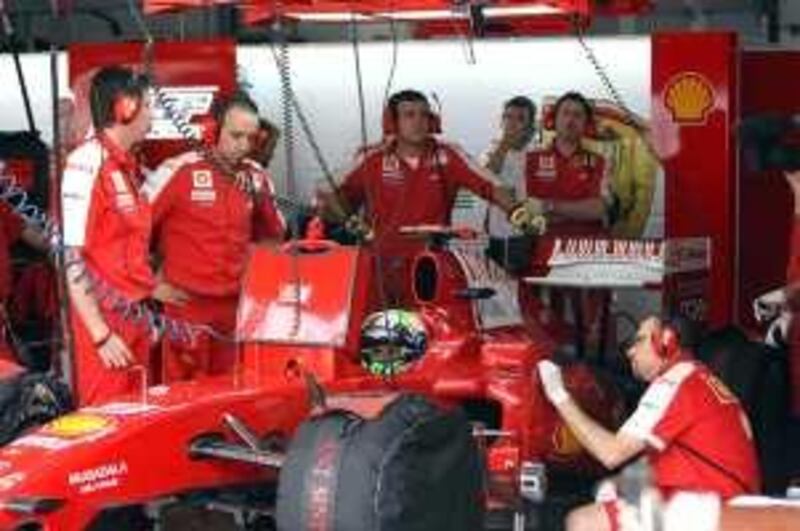Teams burn at least as much money as rubber in their quest for success on the racetrack, with research and infrastructure costs among the sport's participants adding up to billions of dollars during a season as they diligently pursue that most elusive of prizes: victory. Bradley Hope reports When Kimi Raikkonen's finely tuned Ferrari lines up on the grid for the Abu Dhabi Grand Prix on Sunday, you will almost be able to smell the money above the burning tyres and exhaust fumes.
For the Italian sports car giant, this will be the culmination of an estimated US$400 million (Dh1.46 billion) in investment to create a dream machine that can go from zero to 100 miles per hour (160kph) in four seconds. Every nut, bolt and computer chip will have been checked and tested by an army of 700 technicians, mechanics and support staff. During the past eight months at Ferrari's Maranello headquarters in Italy, eight V8 engines at $1m each, will have been stripped down and finessed, while the chassis will have been honed to precision in specially designed wind tunnels. Nothing will have been left to chance.
"Ferrari has a lot of passion," Luca di Montezemolo, the president of Ferrari, told the F1 website. "We want Formula One to be a technologically competitive series where there is competition in which we can develop gearboxes, engines, electronics - and then transfer this to our road cars." Developing technology does not come cheap. Formula One insiders estimated that more than $2bn has been spent by the 10 teams on the F1 circuit this year. The biggest bill was picked up by Toyota with projected outlays estimated at $418m, followed by Ferrari and McLaren on about $400m. Renault was not far behind on $325m, followed by Red Bull on $250m and Williams on $196m.
The picture is more confusing with Brawn, the new constructors and drivers world champions. Jenson Button's car was initially developed by Honda under the direction of the current team principal, Ross Brawn. The Japanese car maker pulled out of F1 at the end of last year after spending more than $480m a year. Mr Brawn then stepped in to salvage the team from the scrapheap. Some observers feel Honda's move was justified.
"There is no business rationale for owning an F1 team," said Tim Urquhart, an analyst at IHS Global Insight. "Now that times are tough for the major car manufacturers, it's much harder for them to justify spending vast amounts of money on F1." BMW became the latest constructor to pull out of F1 earlier this year. While the cost of failure on the grand prix money-go-round can be counted in millions, success can bring in billions. Revenue from F1 was $3.9bn last year and that figure will probably be topped this year.
"This is an event that happens on four different continents, with millions of viewers," said Simon Berger, the director of the Motor Sport Business Forum. "It is one of the best proven global platforms to spread your brand. It's a huge business." Fuelled by sponsorship and television rights, F1 has managed to retain its status as the richest sport on the planet despite being buffeted by the global economic slump. About 100 firms pay more than $800m to be associated with the glitz of grand prix racing, including Mubadala, which owns 5 per cent of Ferrari, and Etihad Airways, a major Ferrari sponsor.
"On the right team and in the right circumstances, a client's brand registration may far outweigh [in terms of the number of seconds his logo is on-screen] any paid-for media," Scott Garrett, the head of marketing for the Williams team, said in the Financial Times. Behind the scenes, millions of dollars are pumped into research and development. One tenth of a second per lap can mean the difference between winning a grand prix race or coming in fifth. With so much money going into the sport, teams have to constantly evolve to stay competitive.
To do this, they have technical laboratories working on engine and aerodynamic modifications. F1 has pioneered the use of ultralight carbon fibre materials. As a result the entire car including the driver, fuel and engine weighs a maximum 605 kilograms. By comparison, a Ford Focus weighs 1,150kg. "Contrary to popular belief, Formula One is not all about glitz and glamour, parties and celebrities," said Ron Dennis, the chairman of the McLaren team "Of course it attracts more than its fair share of all of these but - at its heart, it is about technology and scientific innovation."
McLaren and Ferrari have been key players in the technology race with the development of their own wind tunnels, which are used to perfect new aerodynamic technology. That is changing as big-name companies with deep pockets get more involved in the sport. 1Malaysia, funded by the aviation mogul Datuk Seri Tony Fernandes, is building an F1 centre in the next two years that will include a $17.8m wind tunnel.
Although development costs are high, the innovations pioneered by grand prix teams have led to technologies used in everything from baby incubators to wheel chairs to parts that make cars run cleaner and longer. "The knowledge and experience that designers get from F1 help to accelerate road car development programmes," John Barnard, the legendary F1 designer who perfected the first carbon fibre composite chassis and semi-automatic gearbox, told the International Herald Tribune.
"That's why a lot of big manufacturers are involved in F1. The Japanese used it to educate their young engineers by presenting them with time scales that weren't known in commercial work." While a team's technical director may not stand on the podium at the end of the race, he is just as important as the driver. Take for example Mr Brawn, the man behind this season's world champions. He explained recently that the team decided to write off last season, finishing at the bottom of the constructors table, to concentrate on the following year. The move paid off.
"The thing I always try and introduce to a team is some methodology and some logic in what is being done, and that then gives confidence that you're doing things in a certain way and you're getting results," Mr Brawn said. "You just try and bring that confidence to people, to show that if you do things properly and in the right way and stick at it, then things will come together." bhope@thenational.ae





